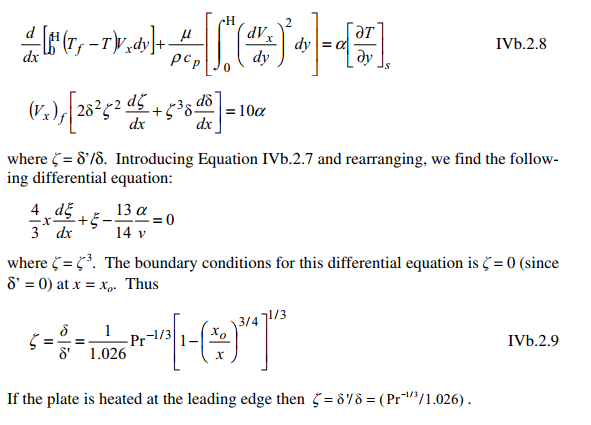12. Start with Equation IVb.2.8 and obtain Equation IVb.2.9. For this purpose, first ignore the non-linear term compared with the two dominant terms. Then sub- stitute for the velocity and temperature profiles. To develop the integral, consider a case where the hydrodynamic boundary layer is thicker than the thermal bound- ary layer (thus the integral is zero for y > 8'). Arrange the result in terms of = 8'18 and ignore *.
12. Start with Equation IVb.2.8 and obtain Equation IVb.2.9. For this purpose, first ignore the non-linear term compared with the two dominant terms. Then sub- stitute for the velocity and temperature profiles. To develop the integral, consider a case where the hydrodynamic boundary layer is thicker than the thermal bound- ary layer (thus the integral is zero for y > 8'). Arrange the result in terms of = 8'18 and ignore *.
Principles of Heat Transfer (Activate Learning with these NEW titles from Engineering!)
8th Edition
ISBN:9781305387102
Author:Kreith, Frank; Manglik, Raj M.
Publisher:Kreith, Frank; Manglik, Raj M.
Chapter6: Forced Convection Over Exterior Surfaces
Section: Chapter Questions
Problem 6.21P
Related questions
Question

Transcribed Image Text:12. Start with Equation IVb.2.8 and obtain Equation IVb.2.9. For this purpose,
first ignore the non-linear term compared with the two dominant terms. Then sub-
stitute for the velocity and temperature profiles. To develop the integral, consider
a case where the hydrodynamic boundary layer is thicker than the thermal bound-
ary layer (thus the integral is zero for y > 8'). Arrange the result in terms of =
8'/8 and ignore *.

Transcribed Image Text:*AP.
dy
dy
ƏT
IVb.2.8
dx
pCp
dồ
= 10a
Sp
dx
where = 8'/8. Introducing Equation IVb.2.7 and rearranging, we find the follow-
ing differential equation:
4 dž
+5
3" dx
13 a
-x-
14 v
where = . The boundary conditions for this differential equation is = 0 (since
8 = 0) at x = x,o. Thus
1
3/4 71/3
r-1/3
5= 1.026
IVb.2.9
8'
If the plate is heated at the leading edge then = 88 = ( Pr/1.026).
Expert Solution
This question has been solved!
Explore an expertly crafted, step-by-step solution for a thorough understanding of key concepts.
Step by step
Solved in 2 steps

Knowledge Booster
Learn more about
Need a deep-dive on the concept behind this application? Look no further. Learn more about this topic, mechanical-engineering and related others by exploring similar questions and additional content below.Recommended textbooks for you

Principles of Heat Transfer (Activate Learning wi…
Mechanical Engineering
ISBN:
9781305387102
Author:
Kreith, Frank; Manglik, Raj M.
Publisher:
Cengage Learning

Principles of Heat Transfer (Activate Learning wi…
Mechanical Engineering
ISBN:
9781305387102
Author:
Kreith, Frank; Manglik, Raj M.
Publisher:
Cengage Learning